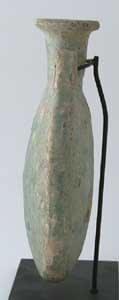Parthian Faience Pilgrim Flask, 100 CE - 300 CE
Faience
4.25 x 5.25
PF.3829a
Further images
After the death of Alexander the Great, his expansive empire was divided among three of his most loyal generals, with Seleucis assuming control of the eastern portion. The Seleucid Dynasty...
After the death of Alexander the Great, his expansive empire was divided among three of his most loyal generals, with Seleucis assuming control of the eastern portion. The Seleucid Dynasty was thereby established, following in the footsteps of the Persian, Assyrian, and Babylonian Empires, with its capitals at Antioch (in modern Syria) and Seleucia (in modern Iraq). However, as history has shown, maintaining calm and order over such a large territory, encompassing so many different cultures, proved difficult if not impossible. In 245 B.C., the Parthians revolted against the Seleucids under the leadership of Satrap Andragoras, igniting a civil war that would lead to further autonomy, despite the continued recognition of the Greek kings as their superiors. Although the Parthians had been mentioned in Assyrian text as early as the 7th Century B.C., it was not until the rise of Mithradates I that the yoke of Seleucid control was toss aside and Parthia reached the heights of its glory. Mithradates the Great quickly conquered the lands of Babylon, Media, and Elam, establishing a great empire that would rival Roman dominance and last until 224 A.D. when the Sassanid Empire finally subjugated their lands.
A disk-shaped body is surmounted by two ring-like handles and a short vertical neck with an everted lip. This presents an appealing sense of circularity and harmony, maintained by the perfect symmetry of the body. The delicate green shade still radiates a soft iridescence beneath and around the encrusted surface. Designed to fit easily into a pocket or pouch, this flask would most likely have contained oil for votive offerings, accompanying a pilgrim on the long and arduous journey to a place of worship.
A disk-shaped body is surmounted by two ring-like handles and a short vertical neck with an everted lip. This presents an appealing sense of circularity and harmony, maintained by the perfect symmetry of the body. The delicate green shade still radiates a soft iridescence beneath and around the encrusted surface. Designed to fit easily into a pocket or pouch, this flask would most likely have contained oil for votive offerings, accompanying a pilgrim on the long and arduous journey to a place of worship.







